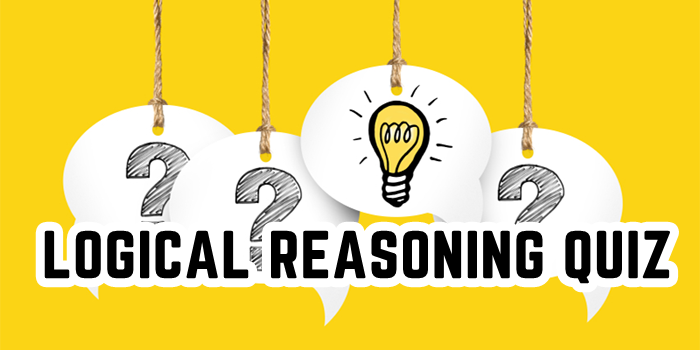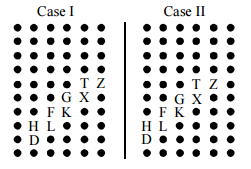Hello and welcome to ExamPundit. Here is a set of Reasoning Quiz for IBPS Clerk Mains 2015.
1. If it is possible to make a meaningful word from the second, the
third, the sixth and the eighth letters of the word POWERFUL, using each letter
only once, then which will be the third letter of the word? If no such word can
be formed your answer’ would be ‘X’, if only two words can be formed your
answer would be ‘Y’, and if more than two words can be formed your answer would
be ‘Z’.
third, the sixth and the eighth letters of the word POWERFUL, using each letter
only once, then which will be the third letter of the word? If no such word can
be formed your answer’ would be ‘X’, if only two words can be formed your
answer would be ‘Y’, and if more than two words can be formed your answer would
be ‘Z’.
1) X
2) Y
3) Z
4) L
5) W
| Solutions – Here the specified letters are: O, W, F and L. Words formed with these letters are as follows: 1. FLOW 2. FOWL (a bird) 3. WOLF |
|---|
2. Mr ‘Y’ started walking along a circular path (around a circular
field) in anti-clockwise direction around the field. When he had walked ‘x’
metres, he observed that he needed to walk ‘x’ metres more to reach the
starting point. Since he was reluctant to walk such a long distance therefore
he followed the shortest route and reached the starting point by walking only
1400 metres more. How much total distance did he travel?
field) in anti-clockwise direction around the field. When he had walked ‘x’
metres, he observed that he needed to walk ‘x’ metres more to reach the
starting point. Since he was reluctant to walk such a long distance therefore
he followed the shortest route and reached the starting point by walking only
1400 metres more. How much total distance did he travel?
1) 6600 m
2) 2900 m
3) 5800 m
4) 3600 m
5) 3800 m
Directions (Q. 3-5): Study
the following information and answer the questions following it.
the following information and answer the questions following it.
There are ten rows and six
columns of boys, ie each row consists of six boys. All of them are facing
towards west. L, K, X and Z are on the immediate right of H, F, G and T respectively.
H, F, G, and T are in front of D, L, K and X respectively. At least four persons
are ahead of Z in his column. Similarly, at least one person is behind D.
columns of boys, ie each row consists of six boys. All of them are facing
towards west. L, K, X and Z are on the immediate right of H, F, G and T respectively.
H, F, G, and T are in front of D, L, K and X respectively. At least four persons
are ahead of Z in his column. Similarly, at least one person is behind D.
3. How many persons
hold positions in G’s column ahead of him?
hold positions in G’s column ahead of him?
1) Five
2) Six
3) Seven
4) Can’t say
5) None of these
4. How many persons
occupy positions left of G?
occupy positions left of G?
1) Two
2) Three
3) Four
4) Can’t say
5) None of these
5. If only G occupies
place between B and K then who occupies place on the immediate right of B?
place between B and K then who occupies place on the immediate right of B?
1) Z
2) T
3) G
4) K
5) None of these
6. How many pairs of letters are there in the word CORPORATION which
have number of letters between them
in the word two less than the number of letters between them in English
alphabet?
have number of letters between them
in the word two less than the number of letters between them in English
alphabet?
1) Six
2) Five
3) Four
4) Three
5) Less than three
Directions (Q. 7-11):
Read the following information and answer the questions given below it:
Read the following information and answer the questions given below it:
A, B, C, D, E, F, G, H, I and J
are ten persons who travel to office everyday by a particular train which stops
at six stations I, II, III, IV, V and VI respectively after it leaves base
station.
are ten persons who travel to office everyday by a particular train which stops
at six stations I, II, III, IV, V and VI respectively after it leaves base
station.
1. D gets in with only I at the
same station on which G gets down with H. But H travels between only two stations.
same station on which G gets down with H. But H travels between only two stations.
2. C gets down before G. A and E
get in alone.
get in alone.
3. B and F get in before D. Also,
both B and F get down at the next station after D.
both B and F get down at the next station after D.
4. G gets in at station I only
with one person. J gets down after one station but he gets in with three
others.
with one person. J gets down after one station but he gets in with three
others.
5. None of them gets in at
station III. Whereas none of them gets down at station V.
station III. Whereas none of them gets down at station V.
7. How many persons
get down at station VI?
get down at station VI?
1) Two
2) Three
3) Four
4) Data inadequate
5) None of these
8. How many persons
get in at base station?
get in at base station?
1) Two
2) Three
3) Four
4) Data inadequate
5) None of these
9. At which station
does D get in?
does D get in?
1) Station I
2) Station II
3) Station IV
4) Station V
5) None of these
10. How many persons
get down before station IV?
get down before station IV?
1) One
2) Four
3) Five or Six
4) Data inadequate
5) None of these
11. In how many
stations the number of passengers (consider only A to J) who get in is equal to
that of those who get down at the
same station?
stations the number of passengers (consider only A to J) who get in is equal to
that of those who get down at the
same station?
1) One
2) Two
3) Three
4) Data inadequate
5) None of these
| Solutions – Let us make a table as shown below and put the information obtained from the clues 4 and 5 in the table. It looks as follow:
Now from clue 1, we get that D and I get in at the same
station where G and H get down. obviously D and I did not get in at base station or station I or III or V. Thus, D and I must have got in either at station II or at station IV. But it is given that H travels between only two stations, hence we can conclude that G and H did not get down at station IV also. Hence, D and I get in at station II and G and H get down at station II. Also, we get that H gets in at station I.
Now, from clue 2, we get that C gets down before G. This
implies that C gets down at station I. Again, from clue 3, we get that B and F get in before D. This implies that B and F get in at base station. Again, from clue 3, we get that B and F get down at next station after D. This implies that, B and F did not get down at station VI (because no person gets down at station V). And since D gets in at station II, this implies that B and F must have got down after at least station III.
Thus, we can conclude that B and F get down at station IV
and D gets down at station III. Again, from clue 2, we get that C gets down at station I before G. This implies that C must have got in at the base station. Also, we get that A and E must have got in either at station IV or at station V. Hence, we can conclude that J gets in at base station (see clue 4) and get down at station I.
Hence, by elimination, we get that A and E get down at
station VI. But still we do not where I gets down among the stations III, IV and VI. Thus the whole information obtained can be summarized as below:
|
||||||||||||||||||||||||||||||||||||||||||||||||||
|---|---|---|---|---|---|---|---|---|---|---|---|---|---|---|---|---|---|---|---|---|---|---|---|---|---|---|---|---|---|---|---|---|---|---|---|---|---|---|---|---|---|---|---|---|---|---|---|---|---|---|
Regards
function answer(id){
if(document.getElementById(id).style.display == “block”){
document.getElementById(id).style.display = “none”;
}else{
document.getElementById(id).style.display = “block”;
}
}
#a1{display:none;}
#a2{display:none;}
#a3{display:none;}
#a4{display:none;}
#a5{display:none;}
Team ExamPundit
Sponsored
(adsbygoogle = window.adsbygoogle || []).push({});
Books For 2015 Banking/Insurance Exams







